
|

|
After releasing the remaining thirty two bears in June, we began the huge job of repairs in and on all the enclosures. If you think one bear can do damage, imagine what all those bears could do. They pulled tree stumps cemented into the ground completely out, tore down all log structures, ripped apart dens, moved huge stumps away from the swim tub like they were twigs, dug big holes in the ground, and on and on. So we made a checklist and started working down the list in every enclosure.
Rake and clean up all boards, sticks, sacks, toys, and general bear junk
Rake up left over dog food kernels scattered by the bears
Turn over all dirt
Haul in new dirt to cover old
Repair all dens with missing boards & totally rebuild two of them
Cut some in half and reframe all the long hollow logs to create smaller more normal size dens
Haul out all the old hay in each den
Several mice decided the bear dens made perfect nests now that the bears were gone. We had to carefully relocate the nests with baby mice (some newborn pinkies) to a crevice we dug under the den for them. We did check and the mother did come back to the newly located nests.
Move dens into new locations (even cut in half it takes 4 people)
Repair the swim tub leaks in all the drain pipes
Use a wet / dry vacuum to suck up the dirt & mud in the bottom of the swim tub
Cement the low area between the front and back part of the new enclosure where the bears dug it out trying to get with Jaws - water was collecting there from the continual gallons they carry out with them each them they lunge out of the swim tub
Both wheels on the gate between the front & back section of the main enclosure still needs to be replaced
Weave new metal poles in the chain link roof seams where the bears had bent them
Rebuild all the log structures & cement the taller ones back in the ground
Rewire a few seams in chain link roof
Mow pasture grass around enclosure - it was now about 4 feet high as we let it grow to provide additional grass for the bears - took almost a full day to cut and gather it
Rake level and prepare for new grass seed in main enclosure
Send one camera in hibernation enclosure in for repair (bears got to it)
Take roof off small cub enclosure den & put back with hinges so we can open it
Replace wire on ground under dirt in small cub enclosure - bears dug it up
Place chain link over welded wire roof and sides of small cub enclosure
Replace black netting outside small cub enclosure that cools it down from the hot sun in the afternoon (which the two Oregon cubs promptly managed reach through & pull down 3 times)
Scatter grass seed in main enclosure
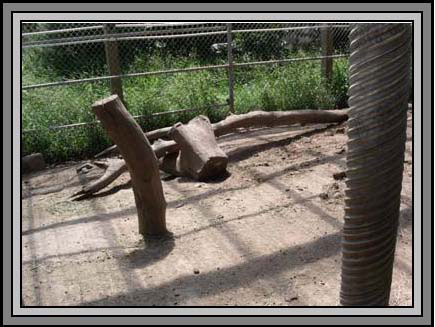
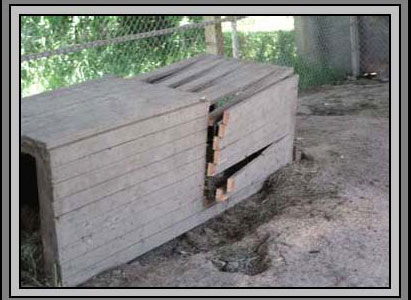
Logs down & pulled out - we are cutting this hollow log into 2 sections for dens
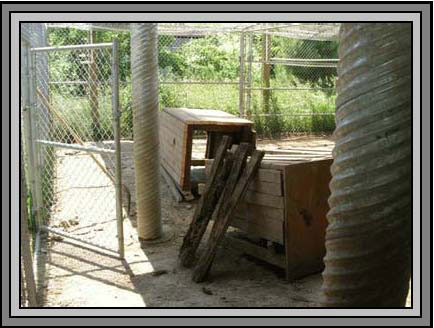
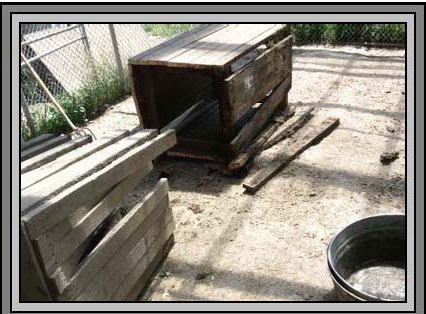
Hollow logs torn up with boards and back panels pulled off
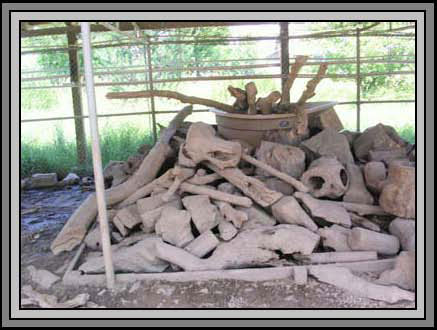
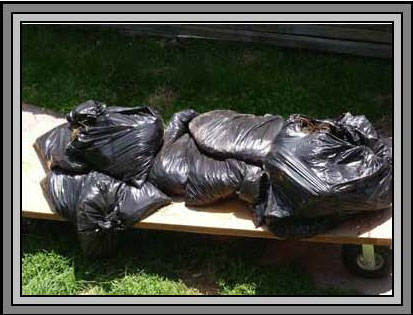
Logs from various log structures piled up in swim tub waiting for us to rebuild the structures. The first of many rounds of trash we hauled out.

Walnut tree that died - we had to cut it down, but made some good bear climbing logs
Oregon Cubs Orphaned
We just finished putting down new grass seed in the main
enclosure when the call came from Oregon Dept. of Fish & Wildlife the end of
July about two orphaned cubs - or soon to be orphaned. Unfortunately, the
mother had been consistently entering a boy scout campground and breaking into
cabins. The boy scouts tried all the right aversion methods as did Fish and
Wildlife, but she would not move on. Finally, out of fear that someone would be
hurt they made the decision that the mother had to be removed. Before doing
anything they called IBBR to see if we could take the cubs.
On July 21, Larry and Terri Limberg left Boise to meet the Oregon Fish &
Wildlife at a halfway point. Oregon sent their carrier back to us with the
cubs in it so we didn’t have to transfer them to our carrier. Due to the haste
with which the cubs had to be transported and the remote location, they didn’t
have any hay available to put in the carrier with the cubs. Traumatized by their
ordeal, the two cubs were frightened and unsure of what was yet to come.
When Terri and Larry arrived about 9pm, it took almost an hour to persuade them
to leave the carrier and enter the small cub enclosure. It was after 10PM
when they finally came out. We left them alone to settle in and Sally
watched them via the monitor for several hours during the night. The first
thing they did was drink every drop of the formula. Then they settled down
to sleep for the next two hours. A little after midnight, they got up and
walked around the enclosure to check it out. Satisfied with what they
found, they ate some of the fruit, yogurt, and cottage cheese. Then it was
back to sleep for the rest of the night.
with the
cubs in it so we didn’t have to transfer them to our carrier. Due to the haste
with which the cubs had to be transported and the remote location, they didn’t
have any hay available to put in the carrier with the cubs. Traumatized by their
ordeal, the two cubs were frightened and unsure of what was yet to come.
When Terri and Larry arrived about 9pm, it took almost an hour to persuade them
to leave the carrier and enter the small cub enclosure. It was after 10PM
when they finally came out. We left them alone to settle in and Sally
watched them via the monitor for several hours during the night. The first
thing they did was drink every drop of the formula. Then they settled down
to sleep for the next two hours. A little after midnight, they got up and
walked around the enclosure to check it out. Satisfied with what they
found, they ate some of the fruit, yogurt, and cottage cheese. Then it was
back to sleep for the rest of the night.
Cubs will always search every inch of the enclosure when they
first arrive. If they don’t find any way out they don’t bother to look
again. After a couple of weeks we moved them to the main enclosure. Four of us walked through it inspecting it inch by inch to be sure we had found
all the necessary fixes from the 2007 bears.The two Oregon cubs are a little different than past twins
that came through the rehab program. At first, like most twins they stuck
close together and depended on each other for reassurance. That seemed to
taper off and we will frequently see one cub up front and the other way in the
back. Although they do play and wrestle, it’s not as frequent as most
twins. At night they do sleep together in the same den. One cub was
in the swim tub almost immediately after moving into the main enclosure.
It took over a week before the other would ever so tentatively put one paw at a
time in the water......until he accidentally fell in one day.
The cubs weighed just under 20 lbs on arrival and by late September we estimate
they weighed 50 lbs. Oregon didn’t have to tranquilize the cubs after they
trapped them so they didn’t know the sex of each cub for certain. We
believe the black cub is a male and the brown cub a female, but the cubs are
keeping that information private for the moment. The only way to know for
sure since we aren’t going to tranquilize at this point is to catch a glimpse
while climbing the wire. Being shy, it’s nearly impossible to catch these
two in time to get a good look. They are long gone by the time we even get
to the enclosure. The other way is to watch them as they strut and urinate.
It’s quite comical to watch us humans peeking around corners or glaring at the
monitor screen while they do their bathroom duties. So far, no definite
conclusion. We named the black cub Tapliwi which is Nez Perce for protect
or defend. In the beginning the black cub tended to protect the other one
and hide that cub with his body. Since the brown cub was more shy, we
named that cub Ilwapa. That is Nez Perce for shy away or avoid.

This den was set up as a hibernation den with a wood panel and entry hole on the front. They decided this one should be their summer home and pulled & chewed the board off except for the flap at the top.
Washington Cub Arrives
A month and a half later on September 7th, IBBR received a call from Rich Beausoleil, an officer in Washington that we have worked with before. He had reports of a tiny cub showing up for the past three days with no mom in sight. He set the trap and quickly caught the bear. After seeing a veterinarian, the cub was ready to transport to IBBR. On September 9th, Larry & Terri Limberg set out to meet him in Spokane. It meant an overnight stay due to the long drive. The following morning Larry & Terri joined Rich while he did a brief educational seminar for his colleagues with the Washington Dept. of Fish and Wildlife. It was a terrific opportunity for him to share information on the handling of orphaned cubs with other officers. They tranquilized the cub to put an ear tag in one ear, determine the sex (female), show the breathing, eye movements, and body movements of the cub while tranquilized.


Meeting up with Washington Fish & Wildlife -
that’s Pearl in the back seat. She belongs to
Terry & Larry (or they belong to her) and is our
official bear greeting dog that goes along on all
bear transport trips.

The 14.8 lb cub arrived late at night just like the Oregon cubs. She had a very tiny body and face so had that extra cute factor going for her. She was even more determined not to come out of the carrier that had been her security for the past two days. Sally doesn’t like to manhandle the cubs with a control stick so we tried everything else - quietly waiting very patiently, a little bit of a rumbling earthquake with the carrier, a pole touching her rump, and finally some metal on metal at the back end of the carrier as the noise will make them uncomfortable and send them to the front of the carrier. One of those tactics always works, but she resisted all that. At one point, we all wished we had a camera. We inserted the metal rod inside one of the holes in the back of the carrier just to touch her lightly and encourage her to move forward. Cubs will often put a paw on the pole and just push it to down to the floor as if to say “that doesn’t scare me”. She did that a few times, but one time she put both paws on the pole and rotated it back and forth just like an Olympic rower would row a boat. It was one of the funniest things we have ever seen a bear do. She kept it up for about half a minute and would have been right in sync with the other rowers if we had placed her in the boat with them.
Loaded up & heading for IBBR

We named her Wiqi which is Nez Perce for abandon since she was left alone. No one knows what happened to her mother. She is extremely shy and it is very hard to get pictures of her. We did manage to take only one when she came out to grab a bite of cottage cheese shortly after she arrived. A little over two weeks later she has gained some weight, but remains tiny in frame. If another cub doesn’t arrive to join her before the second week of October and depending on her condition, we will move her into the main enclosure with the Tapliwi and Ilwapa.
SECOND WASHINGTON CUB ARRIVES
Wasaka
On November 2 IBBR received a call from Washington Dept. of Fish and Wildlife about a 22.6 pound
orphaned cub. No one knows what happened to the cub’s mother. The cub was a male, very light in
color with dark markings. Residents where the cub appeared said it seemed to have trouble eating. The
cub disappeared for about two weeks and then showed up again.
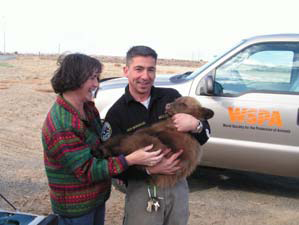
Fish and Wildlife trapped the cub and took it to a veterinarian. It was anemic, thin, and definitely in need
of help. There was nothing lodged in the cub’s throat so if there was a problem, the cub seemed to have
taken care of it. They did the health check, gave the cub a shot of penicillin and antibiotics and prepared
it for transfer to IBBR. IBBR transport team Larry & Terri Limberg met
with Washington Fish & Wildlife at Kennewick WA to bring the cub back
for rehab.
With new arrivals as small as this one, in poor condition, and needing
constant attention, we put them in our small enclosure that is built on
Sally’s deck. It’s totally protected from the weather, gives the cub
enough room to move around, but also let’s the cub access the food
and den area without wasting a lot of energy. We can also attach heat
lamps to help warm the cub. With a camera attached we can monitor
the cub 24 hours a day.
Cubs that arrive late in the year are usually thin and the quickest way to reverse the starvation is to
provide them with formula. Even though weaned earlier in the year, the formula we use for bottle babies
can really help us turn around the effects of starvation. Somehow bears seem to know instinctively as
they always go for the formula first. Then the cottage cheese, yogurt, canned fruit, and finally in a day
or two the solid fruit and dog food.
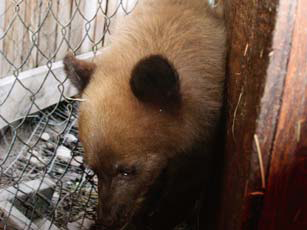 We named the cub Wasaka which is Native American and means strong. He thrived and we moved him
to a larger enclosure two weeks later. He is a shy bear, peeks around
corners when we come to feed and clean.
We named the cub Wasaka which is Native American and means strong. He thrived and we moved him
to a larger enclosure two weeks later. He is a shy bear, peeks around
corners when we come to feed and clean.
He is a playful bear, rolling
in the grass hay, playing footsie with own paws, and hanging from log
structures. It was obvious he needed some buddies to wrestle with
and it wouldn’t be too long before Ano’i Pua and Ka’ahina joined him.
He is a sweet little bear (not something the state wildlife agencies
would want to hear), but in personality, not reality. He is still all bear,
but shows his playful, fun-loving side more than some bears do. He amuses himself with whatever fun things he can find in the enclosure.
In the picture he looks a bit reddish brown, but he is very light in color and his ears, nose, paws all dark
brown so he is a striking bear to look at. His coat is in good shape and given some weight he should
hibernate the first part of February until sometime in March.
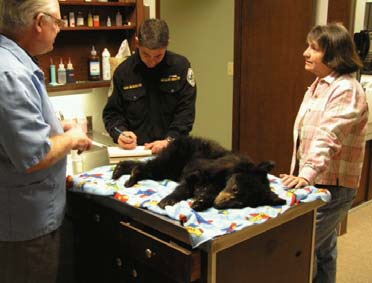 Ano’i Pua is cherished flower in Hawaiian and fits this little female perfectly. She was found wandering in
the back yard of a house near Lake Chelan Washington. We received the call from Washington Fish and
Wildlife on December 8th after they captured her. She was extremely thin, no fat, the pads of her feet
depressed, and oddly enough at this time of year, she had ticks.
Ano’i Pua is cherished flower in Hawaiian and fits this little female perfectly. She was found wandering in
the back yard of a house near Lake Chelan Washington. We received the call from Washington Fish and
Wildlife on December 8th after they captured her. She was extremely thin, no fat, the pads of her feet
depressed, and oddly enough at this time of year, she had ticks.
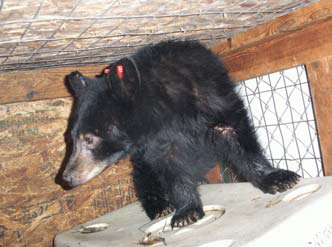 She was doing so well that we moved her to a larger
enclosure next to Wasaka later in December. She weighed in at 31
pounds when we moved her - some of that due to a full belly. Dr.
Tim Murphy came & took a blood sample, which later showed
everything was normal again.
She was doing so well that we moved her to a larger
enclosure next to Wasaka later in December. She weighed in at 31
pounds when we moved her - some of that due to a full belly. Dr.
Tim Murphy came & took a blood sample, which later showed
everything was normal again.
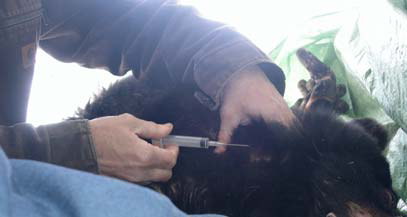 We also knew there was another cub in the Lake Chelan
area that Fish & Wildlife were trying to capture which could
be a sibling to Ano’i Pua and if captured we wanted them
both in the larger enclosure.
We also knew there was another cub in the Lake Chelan
area that Fish & Wildlife were trying to capture which could
be a sibling to Ano’i Pua and if captured we wanted them
both in the larger enclosure.
|
Her journey to IBBR was a long one. Terri & Larry Limberg and Pearl, our official transport dog left Boise for Wenatchee on Tuesday December 16th to pick her up the next day and head back to Boise. They were headed home and got stopped at Pendleton due to closed roads. Since we couldn’t leave the cub unattended in the back of the flatbed truck, Sally spent an hour getting a hotel for Larry, Terri, Pearl and a bear hotel for Ka’ahina. She contacted Oregon Fish & Wildlife to see if we could lock the carrier and cub inside one of their buildings. Thanks to Mark Kirsch, he arranged to have someone meet Terri & Larry and bring them back to the Fish & Wildlife offices. With the help of several people there the carrier with a happy, but slightly curious cub was placed inside a maintenance shed out of the weather for the night. 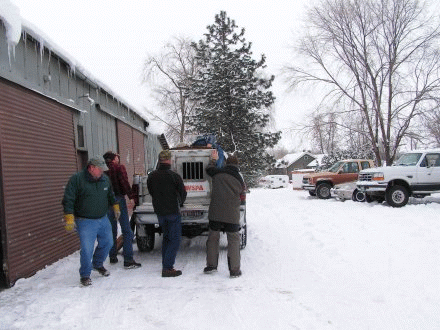
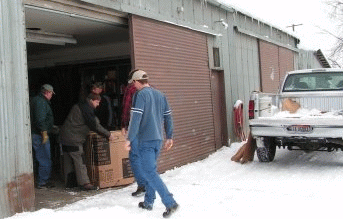
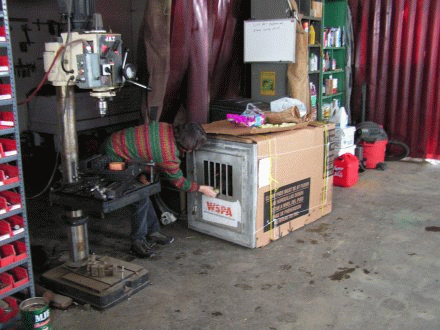 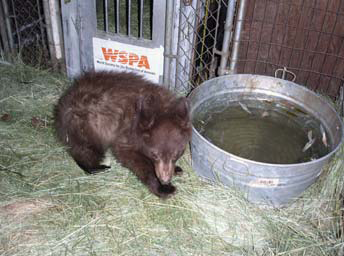 He finally arrived late Thursday night. We opened the door to the carrier & with some encouragement
she finally stepped out into the enclosure. Ano’i Pua peeked out from the den in back and watched the
activity, but had no intentions of coming out. Ka’ahina surveyed the enclosure, drank some water, & then
slowly moved behind a slanted board that provides a hiding area. We watched closely to see if either cub
showed any signs of recognition, but knew it was too soon. Even if they were siblings it would take a
little time for them to come together. For several days Ano’i Pua stayed in the back area and Ka’ahina
remained in the front section. We had to put in two separate water tubs and feed them separately for
the time being. Finally shortly after Christmas, we saw the two
tentatively reaching out with their paws to play. It’s fun to watch
as you can see they are both wanting to play, but fearful they will
be seen as aggressive or threatening. By January 3rd they were
both sharing the back den. Hard to say for sure if they are
siblings or not as most cubs will attempt to make friends, some
sooner than others. We gave them a few days to get acquainted
and then opened the door to the enclosure next to them where
Wasaka stayed.
He finally arrived late Thursday night. We opened the door to the carrier & with some encouragement
she finally stepped out into the enclosure. Ano’i Pua peeked out from the den in back and watched the
activity, but had no intentions of coming out. Ka’ahina surveyed the enclosure, drank some water, & then
slowly moved behind a slanted board that provides a hiding area. We watched closely to see if either cub
showed any signs of recognition, but knew it was too soon. Even if they were siblings it would take a
little time for them to come together. For several days Ano’i Pua stayed in the back area and Ka’ahina
remained in the front section. We had to put in two separate water tubs and feed them separately for
the time being. Finally shortly after Christmas, we saw the two
tentatively reaching out with their paws to play. It’s fun to watch
as you can see they are both wanting to play, but fearful they will
be seen as aggressive or threatening. By January 3rd they were
both sharing the back den. Hard to say for sure if they are
siblings or not as most cubs will attempt to make friends, some
sooner than others. We gave them a few days to get acquainted
and then opened the door to the enclosure next to them where
Wasaka stayed.
Wasaka had been trying very hard to play, but no other bears to wrestle with so he picked a log and did his best. We knew he would be happy to see other bears. On January 19th, he made his way over to their den and did the tentative paw play with them inside the den. They were a little huffy, but he keeps trying. May take a bit longer for the three of them to merge since it’s close to a time when they could start hibernation. If they haven’t merged before then, they will in March and we will then move all three to the main enclosure until release later in spring. |
|
RELEASE OF 2008 OREGON BEARS – JUNE 2009
Oregon Fish and Wildlife released the two Oregon bears, Ilwapa & Tapliwi back in Oregon on June 11, a week after the Washington cubs returned home. Ilwapa burst out of the kennel right away and didn’t give the officers any chance for pictures. However, as if to make up for that Tapliwi did hang around nearby for few minutes. Tapliwi wasted no time eating and was seen munching on grass within a minute of release.
They both connected up soon after the release and will probably stay together for a while. As you can imagine, they provide each other a bit of security in the excitement and uncertainty of their new world. Last word in September was they were still out there being bears, not getting into trouble or causing any problems.
RELEASE OF 2008 WASHINGTON BEARS – JUNE 2009
During the month of June 2009, we released 6 Washington bears and 2 Oregon bears. We only got one or two pictures of the bears this time as they made a quick exit once the doors opened. Tom Hazdor from Wide Eye Productions went on the Washington release. Tom has filmed IBBR bears in previous years so it was fun to have him join us on this release. He was filming for Parthenon Entertainment for a future Animal Planet show. You can read Tom’s comments about the trip on his website blog at http://wideeye.tv/blog/?p=215. right after the portion on Dr. Jane Goodall. As part of our education program, IBBR also sponsored Alison Robinson and Kara Daniels to go on the releases. Alison & Kara are both taking wildlife courses in college. During the summer months they worked for IBBR taking care of the bears until we hired replacements for Jon Knight. Below are short summaries of their experiences on the Washington releases. Alison Robinson Standing on the edge of a worn mountain road my heart beat frantically within my chest. Adrenaline pumped through my veins as my right hand rested on the pea green culvert trap. I jerked my hand back reflexively when it suddenly shuddered violently beneath my fingertips as its live contents snorted and moved about in agitation. I laughed at my jitters and peered cautiously towards the opening. Pacing about in the shadows, I saw the outlines of the two black bears that I helped drive over two hundred and twenty miles (from Idaho Black Bear Rehabilitation to the wilds of Wenatchee, Washington). A sane person would have been terrified, but fear did not grip me. I merely was hyper, aware of my surroundings, my position, and the motion of the bears.My name is Alison Robinson and I am studying at the University of Idaho to become a Wildlife Biologist. After working for two summers at Idaho Black Bear Rehab, I have a healthy respect for wild animals as well as a good understanding of their behavior. I have always possessed the desire to work with wild animals and make a difference in their conservation. So it was my pleasure to partner with the Washington Department of Fish and Wildlife and their talented bear and cougar specialist, Rich Beausoleil to take part in the release of the two bears that I had labored to rehabilitate. When the culvert trap was opened, within seconds the two bears came rushing out and ran into the surrounding woods. I don’t know what I was expecting, but I felt pure jubilation. It is a surreal feeling to know that you have helped to make a small difference and have returned animals to where they belong........THE WILD! Very few people get to experience being near wild animals, but this is the direction my life is heading and I am grateful for every second. I hope to continue such work and positively impact the world of conservation and help preserve species. 
Alison visits with WA Fish & Wildlife Kara Daniels Releasing black bears into their natural environment is very rewarding as I found out this spring. I was privileged enough to attend a three bear release in Washington this June. Wanting to do rehabilitation myself after college, this was an excellent learning opportunity. Sally has been great by teaching me about rehabilitation and what it is all about. By funding my trip to Washington, I got to observe and partake in the activities leading up to the big day.Once in Washington, Rich Beausoleil worked efficiently and explained each step taking place as he prepared each bear for release day. He worked with an amount of professionalism I have not seen before. He loves his job and it shows. By allowing me to help measure and handle the bears he let me understand how quick and precise you must be, especially while working with three bears at a time. This whole experience makes me want to push myself harder and get through school so I can start my career sooner. Helping animals has always been a passion of mine and Sally has sparked my enthusiasm even more. 
Kara Daniels helps untie the carriers with Terri Limberg |